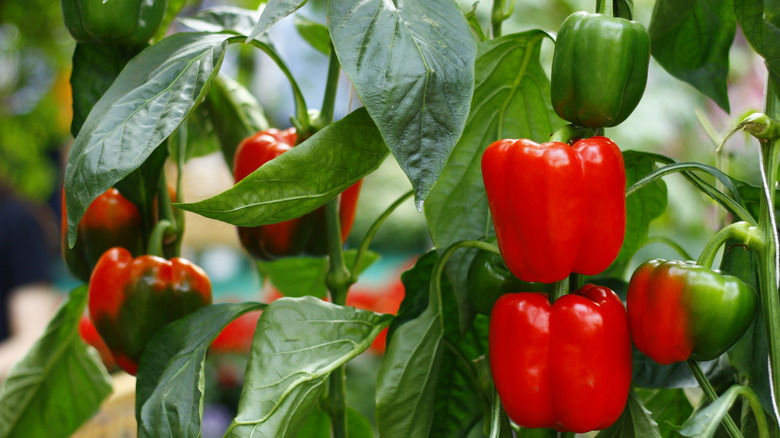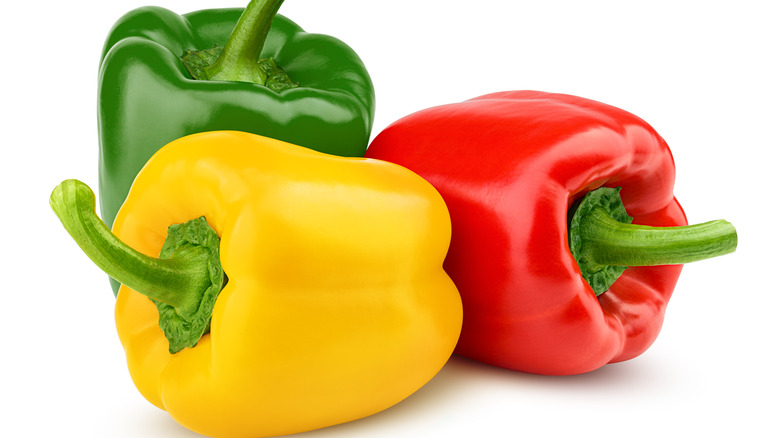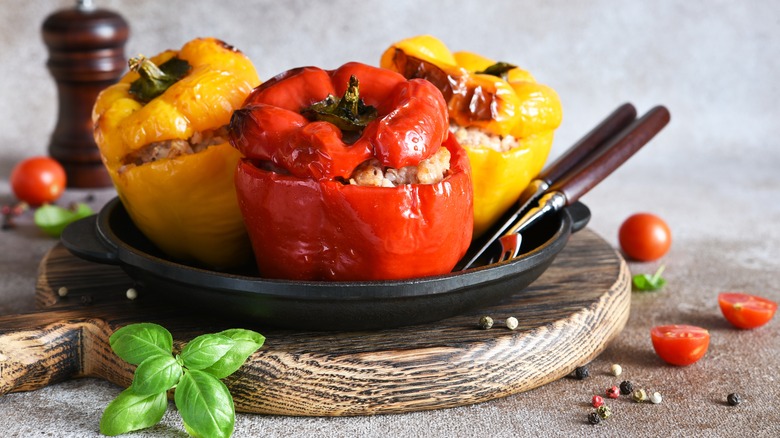Most Of The World's Bell Peppers Come From This Country
There are few vegetables that can claim the ubiquity and usefulness of bell peppers. Whether it's the sweetness of a red and orange, or the slight bitter vegetal bite of a green, bell peppers are up there with carrots and onions as all-purpose workhorses that get constant use, either as an aromatic base like in the Cajun holy trinity, or in any number of salads and soups. According to Fresh Produce, bell peppers are the fifth most purchased vegetable in the United States, behind only old stalwarts like potatoes and tomatoes.
In fact, bell peppers have infiltrated almost every cuisine in the world, you'll find them in Asian stir-frys and turned into Mediterranean stuffed peppers. They are truly an international ingredient that don't really seem like they belong to any one place or culture. For all the peppers you've probably eaten in your life, you may not know much about where they originally came from, or which country is putting them on your plate, but it turns out one place produces the vast majority of bell peppers.
China is king of bell peppers
China absolutely dominates the worldwide production of bell peppers, turning out a whopping 17.6 million tons according to Tridge, which is almost six times the second ranking country, Mexico. Even for an agricultural behemoth with a large population like China, that is impressive. In fact, as of 2020, that is almost half the bell pepper production of the entire world. China isn't the only Asian nation that loves bell peppers either, Indonesia is fourth, and produced an impressive 3 million tons of bell peppers in 2020.
The United States is no slouch in bell pepper production, ranking 10th, but constantly raising demand means we still import a lot of them. According to the University of Florida, bell pepper imports tripled during the beginning of the 21st century, although most of those came from the pepper powerhouse to the south, Mexico, and not China. So even though fajitas came from Texas (via Mexicali Blue), you still have our neighbors to thank for those griddled veggies you are loading onto your tortilla.
Origin of bell peppers
Despite the popularity of both bell peppers and hot chile peppers in Chinese cuisine, the birthplace of the pepper was across the Pacific Ocean, and it didn't reach East Asia until the 16th century (via World Food Story). According to North Carolina State, peppers, including the bell, are native to South America, and they have been cultivated by civilizations in Mexico for over 4,000 years. It's amazing to think that such a common ingredient in so many cuisines was unknown in the Eastern Hemisphere until Christopher Columbus brought them back from his early voyages.
It was Portuguese and Spanish traders who first spread the pepper to Asia from South America. Originally, like tomatoes, it was used primarily as an ornamental plant in Europe, and according to historian Brian Dott in Heated, peppers were used the same way in China. It took a while for it to be adapted into the food culture, with the first records of using it as a spice dating from 1621, and it not becoming more common in cookbooks until almost the 19th century. Now it is so integral to Chinese cuisine, especially in the south, that many people just assume the pepper originated there.
Health benefits of bell peppers
You already know bell peppers are easily available and delicious, but they are also packed full of important nutrients and vitamins. They are high in fiber and folate which helps with both digestion and heart health (via Real Simple). Their positive effect on your heart is compounded by the high presence of potassium as well, which can help reduce blood pressure. Not to mention the fact that bell peppers are also high in vitamin C and vitamin A, which boosts eye health.
Just remember that the types of peppers you are eating and how they are cooked is going to have an effect on how nutritious they are (via BBC). Red peppers are higher in those vitamins than the other colors, because yellow and green peppers are just red peppers that have not fully ripened. Steaming and exposure to other forms of hot, slow cooking can deplete some of bell peppers' nutritional value, although dry heat like stir-frying is better than boiling.
Cooking with bell peppers
So you've got your fresh, healthy bell peppers, but what do you do with them? Perhaps the most classic way to prepare peppers is roasting them, which enhances the existing sweetness while adding a nice savory smoked flavor as well. Roasted peppers can be the centerpiece to a dish, used as a tasty sandwich topping, or even blended into dips. For a quicker, but still delicious, option you can quickly pan fry them, either as part of a stir-fry, or mix with onions and throw them on a Philly cheesesteak.
It doesn't matter if you aren't up for cooking either because bell peppers are one of the tastiest veggies out there when eaten raw. They make a great choice as a dipping vegetable, whether it's as the centerpiece of a veggie tray around tahini goddess dip, or as your hummus vehicle of choice. And of course they are always welcome on a salad, where their sweetness, crunch, and color go a long way towards livening up almost any bowl. However you do decide to use them, you'll always be happy to have some bell peppers in the fridge.




